
Leadtek WinFast A380 Ultra TDH MyVIVO
Written by John Yan on 11/26/2003 for
PC
A review of a NVIDIA card on Gaming Nexus? What is this world coming to?! Ok, we do have a review of an old Ti4200 but it’s been a while since we did feature a NVIDIA card on this site. Yes, we have finally broken the ATi barrier and Leadtek was very generous enough to supply us with NVIDIA’s latest and greatest, a GeforceFX 5950 Ultra. Leadtek’s gone out and deviated from the reference design to add their touches to the card. Titled, the WinFast A380 Ultra TDH MyVIVO, this 256MB card features VIVO functions and sports the fastest chip from NVIDIA available. Let’s see how this card does.

The WinFast A380 Ultra TDH MyVIVO , a GeforceFX 5950 or NV38 card, runs a speed of 475MHz for both core and memory. Since memory is DDR, the speed is 950MHz DDR. Compared to the NV35, it’s an increase of 25MHz for the clock and 50MHz for memory. Memory bandwidth is increased from 27.2GB/s on the NV35 to 30.4GB/s. Unlike the competition’s high end card (ATi), the NV38 is manufactured on a .13 micron process. The Radeon 9800 XT is still at .15 micron but they are using a .13 micron process in their 9600 cards.
Features for the card include 8-pipelines, 256-bit memory bus, and CineFX 2.0 technology. The 5950 is a perfect name for this series as it’s a minor upgrade to the NV35 with no new technologies incorporated. Everything that came with the 5900 is the same with 5950 with a bump in clock speeds. Like the Radeon 9800 XT is to Radeon 9800 Pro, the GeForce 5950 is to GeForce 5900 in terms of features and speed upgrades.
Leadtek’s cooling system differentiates from NVIDIA’s reference design and it actually reminds me of ATi’s Radeon 9800 XT cooling. On the front of the card is a large copper heatsink that covers a good 2/3s of the card. A single large fan produces airflow through the copper fins to cool the card. A grate covers the fan. On the back is what seems to be an aluminum heat sink. Since there is no exhaust system, there’s only one bracket. Does this mean that it’s just a one slot solution? Well, kinda. If you do put another PCI card next to it, it has a good chance of blocking the front of the cooling system. If possible, I’d advise keeping the space clear on the next slot. Some motherboards, like the ABIT NF7-S, has an extra space between the AGP port and the first PCI slot for large cooling solutions. The cooling solution also makes this card very heavy. It’s quiet when no 3D programs are running. Once you start a game, the fan kicks up a few notches and you do hear it. With my system having many silent components, it’s pretty noticeable. Compared to the sound of the Radeon 9800 XT, it definitely generates more noise during 3D operations.


Another good feature that Leadtek has done with the card is the VIVO capabilities. In place of the normal S-Video connector, Leadtek has included an AV cable that has Video In, Video Out, and Component Out. HDTV owners will be happy to see the component connections. With the card, you can also do some multimedia editing and Leadtek has included a Ulead software bundle to assist you. Video Studio 7 SE DVD, DVD Movie Factory 2.5, and Cool 3D 3.0 SE lets you author videos that you capture with the card. And if that's not enough, Leadtek has also included WinFast DVD and WinFast PVR. WinFast PVR allows you to timeshift and record incoming video. Since there is no tuner, you have to have a separate tuner plugged in to the WinFast A380 to watch TV. But if you do, you can watch, record, and interactive with live TV. Picture and picture is also supported by using a recorded video for the second multimedia source. While it's not as advanced as Snapstream or Sage TV, the WinFast PVR allows you to have a poor-man's version of those software and you can record in a good number of formats. WinFast DVD, of course, allows you to watch DVDs on your computer if you have a DVD drive. It's on par with other company's bundled DVD players. The card’s VIVO features give it more use than just a pure gaming card and that adds value. I, being a multimedia enthusiast, greatly appreciate the VIVO features that Leadtek has added to this card.
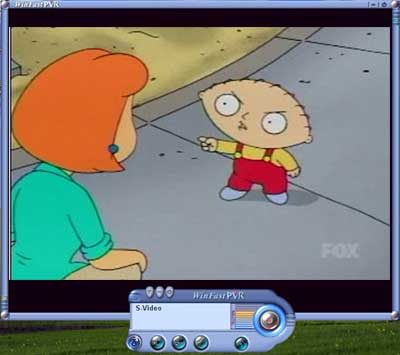
Two games are bundled with the card. Gunmetal and Big Mutha Truckers aren’t AAA titles at all though. I would’ve liked to have seen a better bundle in terms of games, but that’s definitely nothing against Leadtek’s card. The card is the main seller and I’ve never chosen a company’s card over another by factoring in what games they included. With ATI bundling Half-Life 2 and other NVIDIA manufactures bundling some good titles, the Leadtek game bundle could stand for an upgrade.
WinFox is Leadtek's little utility to do various functions such as upgrade your drivers, firmware, overclock your card, etc. The user interface does seem to be a little behind the times though, but that doesn't take away from the tasks it can do. You can even have it remind you to take a break for those that work too long on the computer. The utility puts a lot of options at your fingertips and hopefully Leadtek will continue to improve it.
Here’s the test setup. I am comparing the card to a Sapphire Radeon 9800 XT and a clean copy of Windows XP. After testing the card, I did a clean ghost of the machine so that no residual drivers remained. Catalyst 3.9 drivers were used for the Radeon 9800 XT and version 52.16 WHQL-certified drivers were used for the WinFast A380. The test bed is as follows:
AMD AthlonXP 2500+
ABIT NF7-S motherboard
2 -256MB Crucial PC3200 RAM
120 GIG 7200 RPM Maxtor hard drive
Windows XP Service Pack 1

3D Mark 2001 SE is the first up and a synthetic benchmark from Futuremark. It’s primarily a DirectX 8.1 benchmark. Here are the scores:
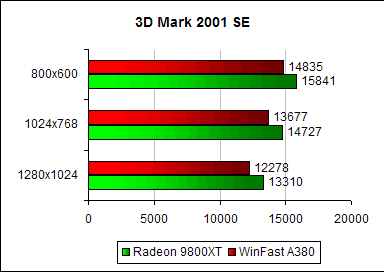
The Radeon 9800 XT beats the WinFast A380 across the board on the tests. Let’s move on to the other Futuremark benchmark, 3D Mark 2003.

3D Mark 2003’s pretty controversial but we have included the scores and the numbers from the four tests and pixel shader test here.
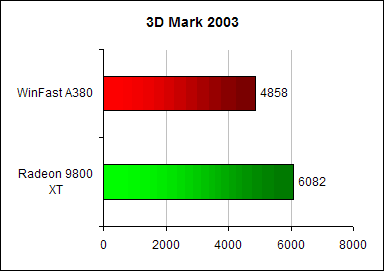
Again, the Radeon 9800 XT performs better than the WinFast A380 on this synthetic benchmark. Pixel Shader 2.0 scores are pretty close though.

Our last synthetic benchmark is Aquamark 3, which is based off a real game engine. The test was conducted with default settings at 1024x768.
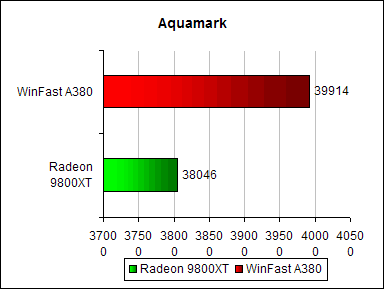
Here, the WinFast A380 takes the lead this time around. Well, that’s all good but it’s really about how it does in real games. So let’s move onto benchmarks with games.
For the review of the WinFast A380, I’ve brought out a few new games to use as benchmarks. With that, we start off with an Xbox favorite and recent PC release, Halo.

Halo is the Microsoft/Bungie/Gearbox first person shooter. Tests were done at three resolutions and using pixel shader 2.0. Here are the scores.
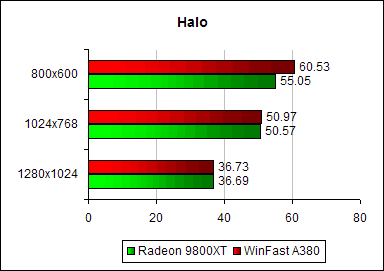
Performance outshines the Radeon 9800 XT a little, but that’s because the latest NVIDIA drivers reduce picture quality. I actually read about this on [H]ardOCP so credit goes to them for pointing this out to me. There are just some things that the NVIDIA drivers don’t render to help increase the speed. In that sense it’s hard to get a fair reading on how the card performs against each other because of NVIDIA’s driver issues. Below are two examples of what the scenes look like on both cards. Screenshots were taken with Fraps and on the timedemo.
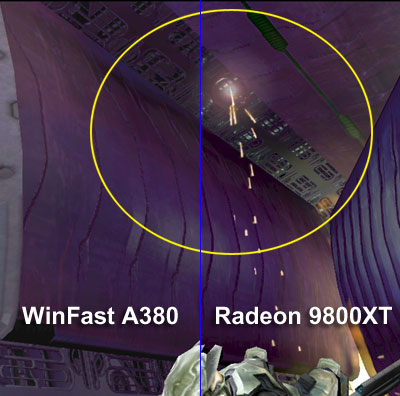
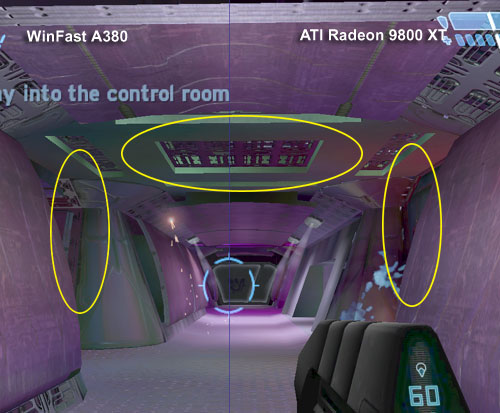
As you can see in the circled areas, there are some lightings that don’t show up on the NVIDIA card but do on the ATI card. Perhaps once new drivers released that render the scenes consistently on both cards, we’ll revisit the test and see how it truly performs against each other.

Splinter Cell is Ubi Soft’s third person stealth game that uses a modified Unreal Tournament engine. We used Beyond3D’s demo and the latest patch for Splinter Cell to run the tests.
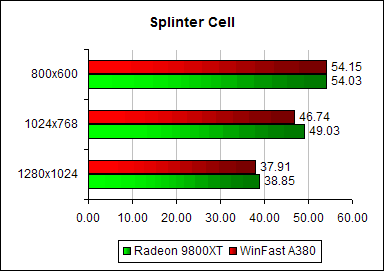
Here the race between the two are pretty close and goes either way.

Square Enix has a Final Fantasy XI benchmark to help determine how well the game will run on your system. Let’s see how the WinFast A380 card does here.
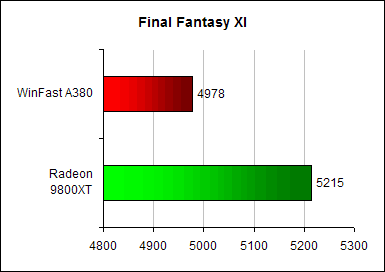
Running the tests at high quality, the WinFast A380 falls behind the Radeon 9800 XT here. For better Final Fantasy XI performance, the nod goes to the ATI card.

Unreal Tournament 2003 was run with [H]ardOCP’s little utility. Tests were run with high quality and at three resolutions. Most tests were consistent in terms of performance difference between the two across the board so I’ll just show the scores for DM-Phobos2 flyby.
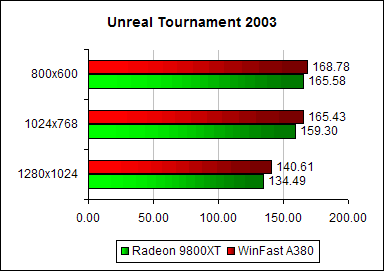
As you can see, the Radeon 9800 XT lags behind just a tad here. Both cards run the game equally well so you can’t go wrong with either one.

The rolling demo of X2: The Threat is another new benchmark used here at Gaming Nexus. The demo goes through various outer space environments with different ship architectures and sizes. Shadows were turned on and three resolutions were tested.
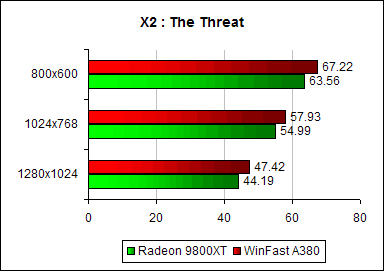
Again the WinFast A380 takes a slight lead over the Radeon 9800 XT card here with a 3 frame per second difference across the board. While viewing the tests, the card’s frames per second does drop a good amount on both cards with large ships or a good amount of action on screen.
The NVIDIA cards offer 8X anti-aliasing and 8X anisotropic filtering. Turning on each function to the max really drops the card’s performance to its knees. How much of a performance hit does it get when both are turned on? Well let’s see on the differences on Unreal Tournament 2003 and X2: The Threat.
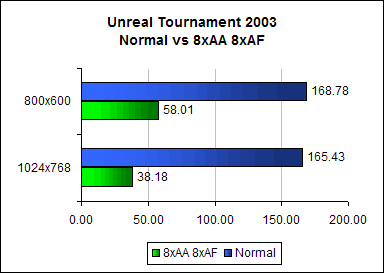
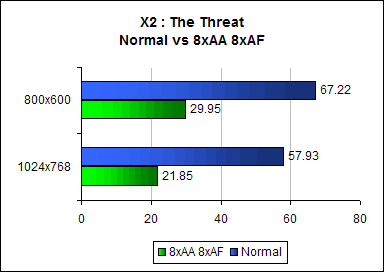
That’s a nice big drop on the two games isn’t it? The X2 demo was extremely choppy at points while the older game, Unreal Tournament 2003 remains playable at 800x600.
Playing a variety of games, I found the card to be stable. I didn’t have any problems with any games I tried and I ran through a good number of old and new games. As I stated earlier, the fan does spin up when you start a game so if you want a quiet system, this card isn’t the one to pick up. It’s louder than a Radeon 9800 XT card when in 3D mode.
A price check using Pricegrabber has the card priced a little less than a Radeon 9800 XT . For a card that performs at Radeon 9800 XT levels and surpass it in some tests, offer VIVO features, and costs a little less than the ATI card, the A380’s price is pretty good. But, that price is still a hefty $400+ dollars and that’s still a large chunk of change to plop down for a video card.
Leadtek’s WinFast A380 Ultra TDH MyVIVO is a very good card for those looking for more than fast game performance. It is rather expensive but unlike the Radeon 9800 XT, you get VIVO features at a price that’s less than the ATI cards. A plethora of cables and connectors along with a nice multimedia bundle highlight this product. The bundled games are a little below average in quality however. There has been a lot of animosity towards NVIDIA with their driver issues and optimizations, but for the most part the card’s a good performer with good picture quality in most games. After a few weeks of using the card, I didn’t run into any problems as the card was stable and solid for all the games I tried. If you’re partial to NVIDIA, have the money to spend, and want the fastest NVIDIA card around the Leadtek WinFast A380 Ultra TDH MyVIVO is a solid pickup.

The WinFast A380 Ultra TDH MyVIVO , a GeforceFX 5950 or NV38 card, runs a speed of 475MHz for both core and memory. Since memory is DDR, the speed is 950MHz DDR. Compared to the NV35, it’s an increase of 25MHz for the clock and 50MHz for memory. Memory bandwidth is increased from 27.2GB/s on the NV35 to 30.4GB/s. Unlike the competition’s high end card (ATi), the NV38 is manufactured on a .13 micron process. The Radeon 9800 XT is still at .15 micron but they are using a .13 micron process in their 9600 cards.
Features for the card include 8-pipelines, 256-bit memory bus, and CineFX 2.0 technology. The 5950 is a perfect name for this series as it’s a minor upgrade to the NV35 with no new technologies incorporated. Everything that came with the 5900 is the same with 5950 with a bump in clock speeds. Like the Radeon 9800 XT is to Radeon 9800 Pro, the GeForce 5950 is to GeForce 5900 in terms of features and speed upgrades.
Leadtek’s cooling system differentiates from NVIDIA’s reference design and it actually reminds me of ATi’s Radeon 9800 XT cooling. On the front of the card is a large copper heatsink that covers a good 2/3s of the card. A single large fan produces airflow through the copper fins to cool the card. A grate covers the fan. On the back is what seems to be an aluminum heat sink. Since there is no exhaust system, there’s only one bracket. Does this mean that it’s just a one slot solution? Well, kinda. If you do put another PCI card next to it, it has a good chance of blocking the front of the cooling system. If possible, I’d advise keeping the space clear on the next slot. Some motherboards, like the ABIT NF7-S, has an extra space between the AGP port and the first PCI slot for large cooling solutions. The cooling solution also makes this card very heavy. It’s quiet when no 3D programs are running. Once you start a game, the fan kicks up a few notches and you do hear it. With my system having many silent components, it’s pretty noticeable. Compared to the sound of the Radeon 9800 XT, it definitely generates more noise during 3D operations.


Another good feature that Leadtek has done with the card is the VIVO capabilities. In place of the normal S-Video connector, Leadtek has included an AV cable that has Video In, Video Out, and Component Out. HDTV owners will be happy to see the component connections. With the card, you can also do some multimedia editing and Leadtek has included a Ulead software bundle to assist you. Video Studio 7 SE DVD, DVD Movie Factory 2.5, and Cool 3D 3.0 SE lets you author videos that you capture with the card. And if that's not enough, Leadtek has also included WinFast DVD and WinFast PVR. WinFast PVR allows you to timeshift and record incoming video. Since there is no tuner, you have to have a separate tuner plugged in to the WinFast A380 to watch TV. But if you do, you can watch, record, and interactive with live TV. Picture and picture is also supported by using a recorded video for the second multimedia source. While it's not as advanced as Snapstream or Sage TV, the WinFast PVR allows you to have a poor-man's version of those software and you can record in a good number of formats. WinFast DVD, of course, allows you to watch DVDs on your computer if you have a DVD drive. It's on par with other company's bundled DVD players. The card’s VIVO features give it more use than just a pure gaming card and that adds value. I, being a multimedia enthusiast, greatly appreciate the VIVO features that Leadtek has added to this card.

Two games are bundled with the card. Gunmetal and Big Mutha Truckers aren’t AAA titles at all though. I would’ve liked to have seen a better bundle in terms of games, but that’s definitely nothing against Leadtek’s card. The card is the main seller and I’ve never chosen a company’s card over another by factoring in what games they included. With ATI bundling Half-Life 2 and other NVIDIA manufactures bundling some good titles, the Leadtek game bundle could stand for an upgrade.
WinFox is Leadtek's little utility to do various functions such as upgrade your drivers, firmware, overclock your card, etc. The user interface does seem to be a little behind the times though, but that doesn't take away from the tasks it can do. You can even have it remind you to take a break for those that work too long on the computer. The utility puts a lot of options at your fingertips and hopefully Leadtek will continue to improve it.
Here’s the test setup. I am comparing the card to a Sapphire Radeon 9800 XT and a clean copy of Windows XP. After testing the card, I did a clean ghost of the machine so that no residual drivers remained. Catalyst 3.9 drivers were used for the Radeon 9800 XT and version 52.16 WHQL-certified drivers were used for the WinFast A380. The test bed is as follows:
AMD AthlonXP 2500+
ABIT NF7-S motherboard
2 -256MB Crucial PC3200 RAM
120 GIG 7200 RPM Maxtor hard drive
Windows XP Service Pack 1

3D Mark 2001 SE is the first up and a synthetic benchmark from Futuremark. It’s primarily a DirectX 8.1 benchmark. Here are the scores:

The Radeon 9800 XT beats the WinFast A380 across the board on the tests. Let’s move on to the other Futuremark benchmark, 3D Mark 2003.

3D Mark 2003’s pretty controversial but we have included the scores and the numbers from the four tests and pixel shader test here.

| A380 | Radeon 9800XT | |
| GT1 | 168.4 | 168.8 |
| GT2 | 34.7 | 45.1 |
| GT3 | 29.5 | 37.9 |
| GT4 | 24.7 | 36.1 |
| Pixel Shader 2.0 | 50.8 | 52.2 |
Again, the Radeon 9800 XT performs better than the WinFast A380 on this synthetic benchmark. Pixel Shader 2.0 scores are pretty close though.

Our last synthetic benchmark is Aquamark 3, which is based off a real game engine. The test was conducted with default settings at 1024x768.

Here, the WinFast A380 takes the lead this time around. Well, that’s all good but it’s really about how it does in real games. So let’s move onto benchmarks with games.
For the review of the WinFast A380, I’ve brought out a few new games to use as benchmarks. With that, we start off with an Xbox favorite and recent PC release, Halo.

Halo is the Microsoft/Bungie/Gearbox first person shooter. Tests were done at three resolutions and using pixel shader 2.0. Here are the scores.

Performance outshines the Radeon 9800 XT a little, but that’s because the latest NVIDIA drivers reduce picture quality. I actually read about this on [H]ardOCP so credit goes to them for pointing this out to me. There are just some things that the NVIDIA drivers don’t render to help increase the speed. In that sense it’s hard to get a fair reading on how the card performs against each other because of NVIDIA’s driver issues. Below are two examples of what the scenes look like on both cards. Screenshots were taken with Fraps and on the timedemo.


As you can see in the circled areas, there are some lightings that don’t show up on the NVIDIA card but do on the ATI card. Perhaps once new drivers released that render the scenes consistently on both cards, we’ll revisit the test and see how it truly performs against each other.

Splinter Cell is Ubi Soft’s third person stealth game that uses a modified Unreal Tournament engine. We used Beyond3D’s demo and the latest patch for Splinter Cell to run the tests.

Here the race between the two are pretty close and goes either way.

Square Enix has a Final Fantasy XI benchmark to help determine how well the game will run on your system. Let’s see how the WinFast A380 card does here.

Running the tests at high quality, the WinFast A380 falls behind the Radeon 9800 XT here. For better Final Fantasy XI performance, the nod goes to the ATI card.

Unreal Tournament 2003 was run with [H]ardOCP’s little utility. Tests were run with high quality and at three resolutions. Most tests were consistent in terms of performance difference between the two across the board so I’ll just show the scores for DM-Phobos2 flyby.

As you can see, the Radeon 9800 XT lags behind just a tad here. Both cards run the game equally well so you can’t go wrong with either one.

The rolling demo of X2: The Threat is another new benchmark used here at Gaming Nexus. The demo goes through various outer space environments with different ship architectures and sizes. Shadows were turned on and three resolutions were tested.

Again the WinFast A380 takes a slight lead over the Radeon 9800 XT card here with a 3 frame per second difference across the board. While viewing the tests, the card’s frames per second does drop a good amount on both cards with large ships or a good amount of action on screen.
The NVIDIA cards offer 8X anti-aliasing and 8X anisotropic filtering. Turning on each function to the max really drops the card’s performance to its knees. How much of a performance hit does it get when both are turned on? Well let’s see on the differences on Unreal Tournament 2003 and X2: The Threat.


That’s a nice big drop on the two games isn’t it? The X2 demo was extremely choppy at points while the older game, Unreal Tournament 2003 remains playable at 800x600.
Playing a variety of games, I found the card to be stable. I didn’t have any problems with any games I tried and I ran through a good number of old and new games. As I stated earlier, the fan does spin up when you start a game so if you want a quiet system, this card isn’t the one to pick up. It’s louder than a Radeon 9800 XT card when in 3D mode.
A price check using Pricegrabber has the card priced a little less than a Radeon 9800 XT . For a card that performs at Radeon 9800 XT levels and surpass it in some tests, offer VIVO features, and costs a little less than the ATI card, the A380’s price is pretty good. But, that price is still a hefty $400+ dollars and that’s still a large chunk of change to plop down for a video card.
Leadtek’s WinFast A380 Ultra TDH MyVIVO is a very good card for those looking for more than fast game performance. It is rather expensive but unlike the Radeon 9800 XT, you get VIVO features at a price that’s less than the ATI cards. A plethora of cables and connectors along with a nice multimedia bundle highlight this product. The bundled games are a little below average in quality however. There has been a lot of animosity towards NVIDIA with their driver issues and optimizations, but for the most part the card’s a good performer with good picture quality in most games. After a few weeks of using the card, I didn’t run into any problems as the card was stable and solid for all the games I tried. If you’re partial to NVIDIA, have the money to spend, and want the fastest NVIDIA card around the Leadtek WinFast A380 Ultra TDH MyVIVO is a solid pickup.
NVIDIA fans out there, Leadtek's card is a good pickup. It's not just a gaming card as the VIVO features and included bundle lets you do more than just play games.
Rating: 9 Class Leading
* The product in this article was sent to us by the developer/company.

About Author
I've been reviewing products since 1997 and started out at Gaming Nexus. As one of the original writers, I was tapped to do action games and hardware. Nowadays, I work with a great group of folks on here to bring to you news and reviews on all things PC and consoles.
As for what I enjoy, I love action and survival games. I'm more of a PC gamer now than I used to be, but still enjoy the occasional console fair. Lately, I've been really playing a ton of retro games after building an arcade cabinet for myself and the kids. There's some old games I love to revisit and the cabinet really does a great job at bringing back that nostalgic feeling of going to the arcade.
View Profile